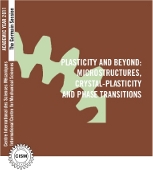CISM Course 2011 - Plasticity and Beyond

CISM Course 2011 (June 27, 2011 - July 1, 2011) Plasticity and Beyond: Microstructures, Crystal-Plasticity and Phase Transitions
KEYWORDS: Continuum mechanics, Plasticity, Computational mechanics, Micro mechanics.
Coordinators:
- Jörg Schröder (University of Duisburg-Essen, Essen, Germany)
- Klaus Hackl (Ruhr University Bochum, Bochum, Germany)
Plasticity is a key phenomenon for a large class of materials with a variety of applications in science and technology. In the last few decades several phenomenological theories have been developed in order to describe the mechanics and thermodynamics of such processes on the macroscopic level. Nevertheless, these “classic” models have reached their limits in various respects. Extensions of these models should take into account the formation of microstructures and the microheterogeneity of the underlying multiphase materials. The macroscopic response functions are determined by appropriate averages of microscopically associated field quantities over evolving microstructures.
The role of microstructures becomes more and more noticeable with a decreasing size of the material specimen considered. Scale-effects play a major role in modern micromechanical applications. Microstructure is indeed crucial, since plastic behavior typically is the result of the interaction of complex substructures on several length scales. The macroscopic behavior is then determined by appropriate averages over the (evolving) microstructure.
What is needed are models which are more closely related to physics and material science and which are able to take into account the microstructural behavior of the material. These models rely strongly on variational formulations for which effective mathematical and numerical concepts have been developed only recently.
Modern engineering applications require the reduction of structure weight while improving safety properties. Therefore, advanced high strength steels play an important role since they offer solutions to these demands. Due to their micro-heterogeneity high strength steels pose outstanding challenges with respect to material modeling. In order to capture the complex interplay between the individual constituents a multi-scale modeling technique has to be applied. In a first approach an applicable numerical tool for the direct incorporation of these micromechanical information is the FE2-method (two-scale approach). A main problem of such direct homogenization methods applied to large random microstructures is the high computational cost with respect to both, the amount of memory and the computation time. Therefore, the construction of statistically similar representative volume elements (SSRVEs), which are characterized by much less complexity than usual random RVEs is applied to overcome this drawback.
The aim of the course is to join world leading experts in the area of experimental plasticity, crystal plasticity, phase transitions, advanced mathematical modeling and multi-scale modeling. The course is organized so as to approach the above mentioned problems from different perspectives.
Modeling techniques: They will cover concepts of classic and extended continuum thermodynamics, phase-field modeling, higher-order models like gradient plasticity or micropolar models at finite deformations. The associated algorithmic treatments are mainly based on finite element formulations for standard (local approach) as well as for non-standard (non-local approach) continua and for pure macroscopic as well as for directly coupled two-scale boundary value problems.
Applications: The course will cover some of the most important application areas in material design/processing ranging from grain boundary effects in polycrystals and phase transitions to deep-drawing of multiphase steels by directly taking into account random microstructures.
The course is addressed to Doctoral students, young researchers.
A problem for young scientists trying to do high level research in this area is the number of topics one has to be familiar with: Experimental observations, continuum thermodynamics, crystal physics, dislocation theory, phase transition, generalized convexity analysis and formation of microstructures, phase-field-modeling, multi-scale modeling, and the algorithmic modeling of this highly non-linear processes. For a significant progress, high quality research and innovative applications it is important to know the essentials in these fields and their respective interplay. Furthermore, there are neither adequate textbooks nor advanced courses at research/university level available. The aim of this CISM course is to fill this gap.
Lecturers
- Samuel Forest (Ecole Nat. Superieure des Mines, Evry, France)
6 lectures on: Micromorphic crystal plasticity and microstructure evolution during phase transitions. Mechanics of generalized continua. Plastic microdeformation field within a continuum thermomechanical framework. Strong plastic strain gradients in polycrystalline aggregates.
- Klaus Hackl (Ruhr University Bochum, Bochum, Germany)
6 lectures on: Variational framework for inelastic materials. Minimization problems involving nonquasiconvex potentials. Initiation of material microstructures. Finite crystal plasticity. Relaxed energies and dissipation potentials. Evolution of microstructures.
- Jan M. Kratochvil (Czech Technical University, Praha, Czech Rep.)
6 lectures on: Formation of deformation substructures, types of observed dislocation structures in single crystals and polycrystals induced by tension, compression, cycling and severe plastic deformation. Theoretical models of substructure formation treated as an instability of deformation modes.
- Mitsutoshi Kuroda (Yamagata University, Yamagata, Japan)
6 lectures on: Scale-dependent crystal plasticity: Foundation and experimental observations. Origins of the size effect. Work-conjugate and non-work-conjugate type of gradient-dependent crystal plasticity formulations. Numerical methods and examples.
- Valery Levitas (Dept. of Mechanical and Aeronautical Engineering, Ames, IA, USA)
6 lectures on: Mechanically induced phase transformations (PT) and chemical reactions. General thermodynamic and kinetic theory of PT in elastoplastic materials. Nano- and microscale phase field approach to martensitic PT, multivariant microstructure evolution.
- Jörg Schröder (University of Duisburg-Essen, Essen, Germany)
6 lectures on: Direct micro-macro-transition procedure (FE2-method). Consistent linearization and computation of overall moduli. Scalar-valued and higher-order statistical measures and design of suitable statistically similar representative volume elements. Applications.
